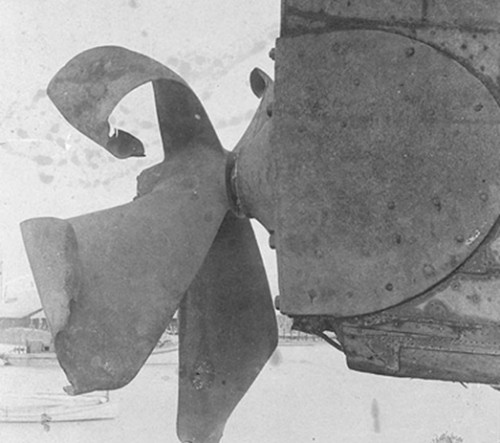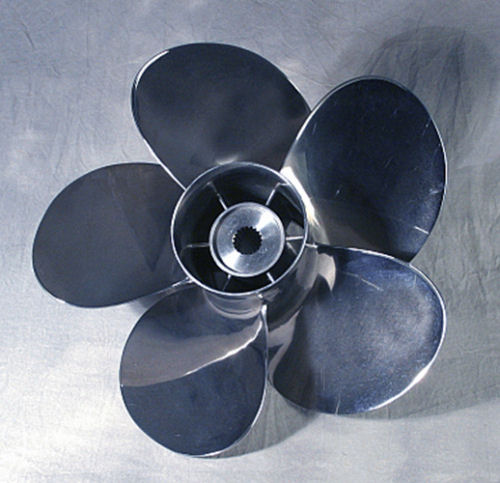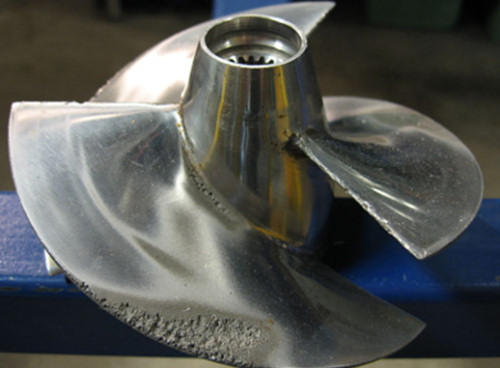Spring Prop Check: Are You Propped Right?
In spring, a young man's fancy turns to thoughts of ... propellers? With apologies to Tennyson, more of BoatTEST.com's readers think of their propellers than they do of love – at least, we think so. And what better time to order a new prop, or at least confirm that your present one is just right, than now, when your boat's out of the water and you can get to her running gear without holding your breath?
 We hope your prop isn't as bent as this one, but even if it looks OK you might be surprised how much a new one will improve your boat's performance. |
Submit a propeller worksheet here...
When it comes to performance, your propeller is the most important thing on your boat. Spinning the wrong one can waste power, reduce top speed, increase fuel burn and/or produce excessive noise and vibration. If your boat shows any of these symptoms, spend a bit of quality time now with a propeller expert, and maybe a bit more money (OK, quite a bit more) on a new prop – the fuel you save over a couple of seasons could well pay for it, and your boat will feel like she's new again.
But before calling in an expert we recommend the folks at PowerTech! Propellers (www.ptprop.com) in Shreveport, LA. (If anybody knows more about props than those guys, we haven't found them yet.) You'll need to gather some facts and figures. The more accurate the info you give them, the better they'll be able to analyze your situation. PowerTech! has a prop worksheet on their website that you can fill out and send to them for technical assistance; this is what they ask for:
Boat Information
Make and model of your boat, hull length, material – those are easy. What's difficult is estimating her weight. It's almost certainly more than on the spec sheet, since you've added all kinds of things – tools, gear, utensils, safety equipment, and so forth; even dirt in the bilge and antifouling paint on the bottom add weight. And don't forget to add the weight of your typical crew (Uncle Joe has been putting on weight recently) and average levels of fuel and water; figure 7 lbs/gal for fuel, 8 lbs/gal for water. Horsepower-to-weight ratio is one of the most important factors in predicting speed, so do your best working out your boat's real weight.
Motor ID Plate
You'll want your boat's top speed and maximum rpm, and typical cruising speed and RPM. If your fuel consumption increased markedly last year vs. the season before, make a note of that, too – it can point to other performance-robbing factors, like engine problems or excess weight on board. (See above.)
 This PowerTech! BRA5 is designed for heavy boats that need lots of blade area – it's probably not the prop you need, but it looks too cool not to show. It's 18.5" diameter and comes in pitches from 15" to 24", right- or left-hand rotation. In short, it's one big prop! |
Motor Information
Now it's time to head for your boat. Take a tape measure, flashlight, magnifying glass, notebook and camera with you. Along with the year, make, model and horsepower of your engine(s), you'll need the serial number and, for inboards, the reduction ratio off the plate on the transmission. For stern drives, note if the exhaust is through the hub, underwater, through the transom or via a Captain's Choice or another selectable method.
Prop Information
For inboard engines, the propeller's diameter and pitch are stamped on the hub – "12x12" for example. Make a note of the rotation, either "right hand" (spins clockwise when viewed from astern to go forward) or "left hand" (counterclockwise). Sometimes "RH" or "LH" are also stamped on the hub. Note the material, although most inboard props are bronze or some alloy, the number of blades and, if possible, the manufacturer. Record any serial numbers, too.
 Chronic cavitation can eat away even a stainless steel prop. |
For outboards or stern drives, get the manufacturer, model number and serial number off the prop -- record any numbers you see. Note the material – stainless or aluminum – and the number of blades. Basically, the more information you have, the better.
While you're at it, check your prop for damage – nicks or dings, tip erosion, even a twisted blade. Inspect both sides of the blades for pitting, especially near the tips, which can indicate chronic cavitation due to overloading.
Crunch the Numbers
Armed with as much data as you can collect, contact PowerTech! and let them crunch the numbers. They'll ask you about hole shot, acceleration, minimum planing speed, performance issues (porpoising, blow-out, etc.) and so forth. Based on the information you provide, they'll tell you if you already have the correct prop, or if you'd be better off with one that's a little different.
If you need a new prop, now's the time to order one.